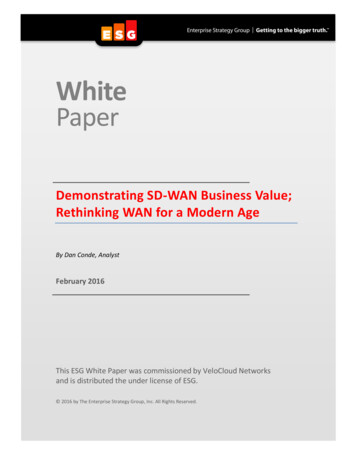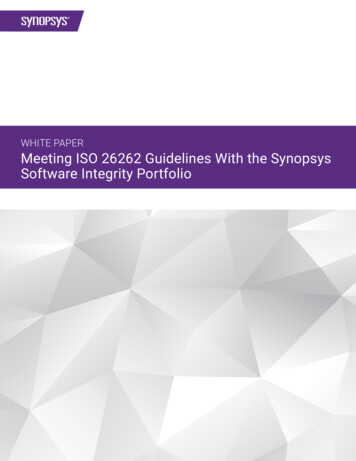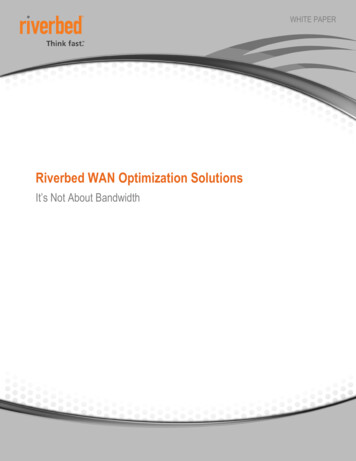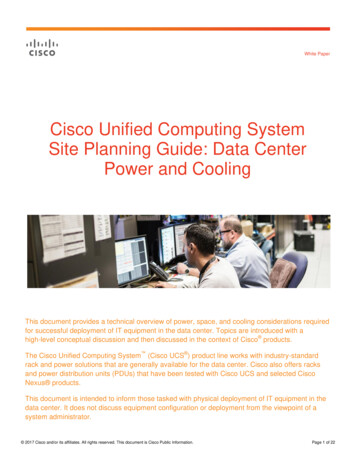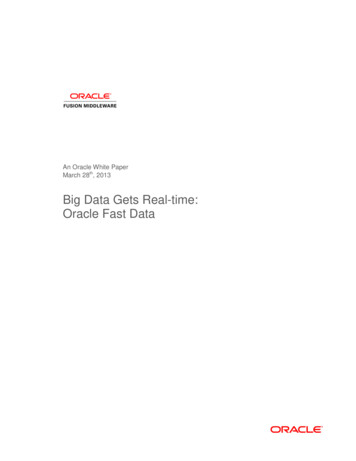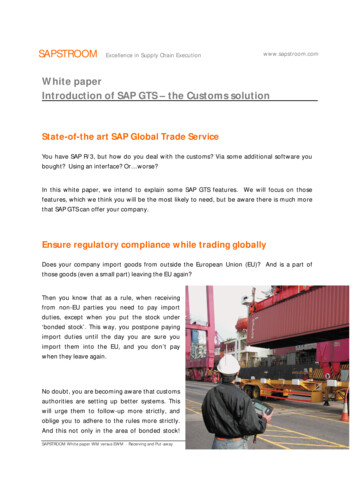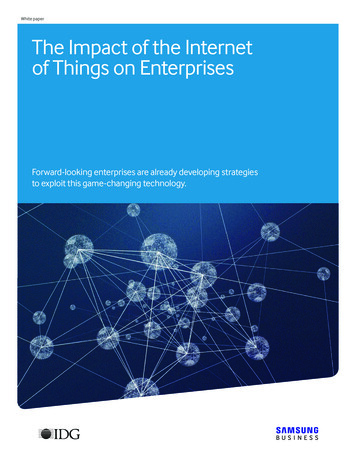
Transcription
White paperThe Impact of the Internetof Things on EnterprisesForward-looking enterprises are already developing strategiesto exploit this game-changing technology.
2Internet of ThingsPageIoT is already delivering business benefits3Challenges to adoption4Conclusion6The Internet of Things is bringing the physical and digitalnow stand to benefit both operationally and strategically;worlds together. Imagine homes and cars getting to know ourthose that don’t do so risk getting left behind.preferences and adjusting to us before we’re even in the door.Imagine banking and financial services getting more secureIoT is about networks of sensors, devices and other “things”through automation that bypasses insecure elements such asconnecting over the Internet to share data with each otherpasswords. Imagine improved precision and privacy in healthand with the organizations that deploy them. By applyingmonitoring in addition to objects that offer intelligence toanalytics and data management to the information collectedpersonally affect our lives. We can improve energy and waterby these things, IoT is able to generate the insight needed toconservation and adapt our very environment to our needs.enable new services, features and functionality that previouslyAnd big data will give us new and actionable insights, enablingwere time- and/or labor-intensive. These capabilities can beus to harness intelligence for a better-integrated global society.used to reduce costs, improve productivity and create betteruser experiences. IoT helps solve challenges as targeted asThe connected world enabled by IoT will not only changesmoothing out the bumps in a company’s supply chain or asour lives as consumers but will also have a meaningful impactbroad as helping organizations overcome the barriers to entryon the way businesses operate. Imagine if a piece of machinein new markets. And by enabling devices to do the routineequipment on a production line could self-diagnose a problemwork of collecting and sharing data without requiring humanand automatically call customer support at an equipmentinvolvement, enterprises can free their employees to focus onmanufacturer to order a replacement, which then can bemore-strategic efforts.fitted before the existing part fails. Imagine a retailer havingan automatic inventory management system that predictsThe future is bright for the adoption of IoT. Approximately 3.9and issues notifications about inventory needs to assurebillion connected things were in use in 2014, and this figure isthe optimum supply of items across stores and distributionexpected to rise to 25 billion by 2020, according to Gartner.1channels. Imagine an automated supply chain system thatAmong the companies participating in a recent IDG Enterpriseenables companies to have two-way communications withsurvey, 56 percent already have IoT on their radar or are activelyshipments at each stage of the journey. The opportunitiesresearching it and 32 percent said that IoT will be a top tech-enabled by IoT for enterprises are endless.nology investment in the next year. Organizations that trulyembrace IoT over the long run stand to benefit significantly;Driven by devices that collect data and share informationaccording to Verizon’s State of the Market: The Internet ofover the Internet, IoT promises to redefine user experiences,Things 2015 report, by 2025 those companies that extensivelyautomate and streamline processes and improve efficiency.use IoT technologies in their products and operations will be asEnterprises that begin developing strategies to embrace IoTmuch as 10 percent more profitable than those that do not.2
3Internet of Things“The ‘Internet of Things’ (IoT) has rapidly become one of theHere are some examples:most familiar (and perhaps most hyped) expressions acrossbusiness and technology. Gartner forecasts tremendous bene-Operational efficiency—Industrial companies can use datafits resulting from the IoT, but the ways in which enterprisesgathered from sensors and apply advanced analytics to thatcan actualize any benefits will be diverse and, in some cases,data to detect the health of equipment and machinery inpainful,” writes Gartner analyst Jim Tully in a recent report.the field without having to send maintenance crews to the“Enterprises will need to make plans and preparations now orsite. Commercial buildings can be equipped with sensorsrisk being left behind by their faster moving competitors.”that determine the optimum temperature and automatically3adjust heating and cooling to maintain a comfortable workenvironment while also cutting energy costs. ManufacturersIoT is already delivering business benefitscan connect their production-line systems to automaticallyAlthough IoT is still considered by most to be a new technology,enterprises in a variety of industries are already benefitingfrom it. In sectors ranging from healthcare to shipping andgovernment, IoT is enabling new products, processes andbusiness models. And it’s just beginning; as the technologiesinvolved in IoT mature and companies start building uponthe success of their pilot projects, the trend will benefit fromthe network effect—the more devices that communicate andshare data over the Internet, the more useful the informationand insight they generate becomes.therefore reducing downtime and increasing efficiency whileboosting plant output in the same period of time.Customer service—Manufacturers can use IoT-enabledasset tracking so they can offer their customers superiorself-tracking capabilities and anticipated delivery times,helping them stand out among their competitors. Carmakerscan create connected vehicles that boost the safety ofdriving by offering features such as lane-alert sensors; automatic headlights, wipers and calls to emergency services;Samsung sees four significant benefits to be reaped by thoseenterprises that understand and embrace this technology.OperationalEfficiencyredirect workloads to take advantage of equipment not in use,and the ability to automatically perform vehicle diagnostics.Strategic decision-making—Retailers can use analyticsto shift through massive amounts of data gathered by IoTCustomerServicesensors to make better decisions—often in near real time—about how to interact with customers, such as spotting buyingtrends that may lead to sales opportunities. They can useStrategicDecisionMakingImpactof IoT onEnterprises RIntraOrganizationalCollaborationthe information customers offer them (when setting up onlineprofiles, for example) and combine it with purchasing historiesto generate additional sales while also catering to customerneeds. For instance, if a customer profile shows that a womanhas purchased maternity clothing and prenatal vitamins at astore, that retailer can target promotions related to baby gear.Intraorganization collaboration—Smart, connected machinerycan generate essential data that can be used to inform manufacturers how well the product operates, the ways it is beingSource: Samsung Strategy & Innovation Centerused and signs that could indicate that maintenance is required.
4Internet of ThingsThis information can be used by many different departmentsat a manufacturer: Sales and Marketing can use the data tobetter understand customer usage patterns, R&D can improveproduct operation and reliability, Service can more accuratelypredict when maintenance or a replacement is needed andManufacturing can better track and spot quality issues.“Samsung believes that virtually all electronic devices willconnect to the Internet and be capable of communicatingwith each other. By connecting more devices to the Internet,additional new services and functionality can be created toimprove productivity and create better user experiences,”says Young Sohn, president and chief strategy officer ofChallenges to adoptionAs with any new technology, there are some hurdles aheadfor IoT. Among the most pressing:Platform incompatibility—IoT will require platforms that areopen and interoperable for widespread adoption to occur.Without this openness, isolated islands of proprietary technology will be created, and one of the fundamental tenets ofIoT—the uninhibited sharing of information by devices—willbe negated. In the long term, global partnerships will emergethat consolidate options down to a core set of establishedIoT ecosystems based on interoperability and openness.Samsung Electronics.SAMSUNG’S ARTIK PLATFORM: UNLEASHING THE POTENTIAL OF IoTSamsung’s ARTIK platform is designed to accelerate development and deployment of IoT. This open platformincludes all the essential hardware and software building blocks needed to create IoT devices, along withconnectivity and security features to enable faster, simpler development of new enterprise, industrial andconsumer IoT applications.ARTIK KEY BENEFITS: Developer-friendly, open,end-to-end platform Small form factor Low power consumption Advanced security features
5Internet of Things202020152014 Samio.io2010/2011 Smart TV Smart Fridge Simband Smart Things 405M mobilehandsets* Commitmentto an OpenEcosystem100%SamsungDigitalAppliancesConnected 100MDeveloperInvestment Smart LightingAnnouncement2000 ERA First SmartWatch Cell phones* Strategy AnalyticsIn the meantime, Samsung is working to create an open IoTDifficulty extracting meaningful insights—Data analysisplatform and developer ecosystem called SmartThings, whichand management will be required to make sense of all theworks with more than 100 devices and has 10,000 developersinformation coming in from these connected devices. Withoutwriting for it. Samsung is also participating in industry-specificthe right tools, knowledge and experience to analyze andinitiatives in areas such as manufacturing, transportation, smartmake sense of the data, companies will be left with petabytescities and consumer applications to help these groups realizeof information pouring in but no ability to draw insights from itwhat is possible with IoT.in a timely manner. Enterprises need the right resources andinformation management strategies to filter, categorize andFor example, Samsung is in partnership with carmaker BMWanalyze this data in near real time.to connect the company’s BMW i3 and BMW i8 auto modelswith the Samsung Gear S Smart Watch. This connectivityTo this end, Samsung is offering a suite of analytics and unifiedenables users to leverage IoT capabilities such as being ableintelligence solutions through partnerships. For example,to remotely check battery levels or control the car’s cabinthe company is working with organizations in the healthcaretemperature. Samsung and Volkswagen are also workingindustry to develop the Samsung Digital Health platform, antogether so that the Samsung Galaxy smartphone’s displayintegrated system that connects sensors, algorithms, devicescan be mirrored on the head units of Passat models, enablingand partners’ platforms to manage patients’ health, fromthe car’s occupants to have the same user experience insidefitness to medical care. The company’s mobile monitoringthe car as they do on their phones.app collects patient data such as weight, blood pressure and
6Internet of Thingsexercise patterns and then pushes this information to the cloudfor analysis and real-time review by doctors. Not only doesthis initiative engage patients in their own healthcare but it alsoenhances their access to medical professionals.Lack of security—Currently most connected devicescreate and transmit data to a corporate network or the cloudwithout using encryption. Yet many of these devices areused in sensitive, mission-critical settings such as healthcareand financial services. IoT must be secure to be successful;security and privacy should be integrated into IoT productsat inception, and mobile security platforms need to beextended to protect IoT devices.Samsung’s KNOX mobile security platform is built into thecompany’s newest mobile devices to securely save, manageand transfer data, and the company is actively integratingKNOX into a variety of Samsung IoT platforms, devices andsolutions. Samsung has also developed KNOX Workspace,which is tightly integrated with the KNOX platform andenables IT administrators to set up secure containers sothat corporate information and applications can reside ona mobile device but remain separate from the user’s personalConclusionIoT has the potential to truly change the way information isshared, work gets done and value is generated. There arehurdles to overcome, but IT industry players have alreadybegun working together to build open, flexible platformsfor IoT that will create value for enterprises.As more companies craft comprehensive IoT strategies andmake significant investments in IoT, the business advantagessuch as increased productivity, reduced costs and greaterinnovation will be hard to deny. It’s clear that, over the nextfew years, IoT is poised to become a game-changing technology that has the ability to make or break enterprises.“Internet-connected, intelligent objects have the potential tofree us from many routine tasks and enable us to focus onwhat human beings are really good at: generating ideas,”says Won Pyo Hong, president and chief marketing officerof Samsung Electronics. “In the enterprise sector, thisfreedom has tremendous implications in terms of costreduction, increased productivity and enhanced valuefor end customers.”data and applications.The more devices that communicate and share dataover the Internet, the more useful the informationand insight they generate becomes.For more information, visit www.samsung.com/business.1Gartner, “The Internet of Things Enables Digital Business,” t-of-things/.2Verizon, State of the Market: The Internet of Things 2015, et-internet-of-things/? ga 1.207057811.1274185408.1432652913.3Jim Tully, Gartner, “Mass Adoption of the Internet of Things Will Create New Opp
Internet of Things In the meantime, Samsung is working to create an open IoT platform and developer ecosystem called SmartThings, which works with more than 100 devices and has 10,000 developers writing for it. Samsung is also participating in industry-specific initiatives in areas such as manufacturing, transportation, smart

